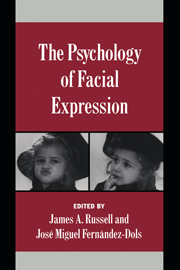Book contents
- Frontmatter
- Contents
- Foreword
- Preface
- Contributors
- Part I Introduction
- Part II Three broad theoretical frameworks
- Part III With a biological and developmental focus
- Part IV With a psychological and social focus
- 10 A Componential Approach to the meaning of facial expressions
- 11 Spontaneous facial behavior during intense emotional episodes: Artistic truth and optical truth
- 12 Is the meaning perceived in facial expression independent of its context?
- 13 Reading emotions from and into faces: Resurrecting a dimensional-contextual perspective
- 14 Facing others: A social communicative perspective on facial displays
- 15 Faces in dialogue
- Part V Integrative summary
- Author index
- Subject index
- Studies in Emotion and Social Interaction
11 - Spontaneous facial behavior during intense emotional episodes: Artistic truth and optical truth
Published online by Cambridge University Press: 11 March 2010
- Frontmatter
- Contents
- Foreword
- Preface
- Contributors
- Part I Introduction
- Part II Three broad theoretical frameworks
- Part III With a biological and developmental focus
- Part IV With a psychological and social focus
- 10 A Componential Approach to the meaning of facial expressions
- 11 Spontaneous facial behavior during intense emotional episodes: Artistic truth and optical truth
- 12 Is the meaning perceived in facial expression independent of its context?
- 13 Reading emotions from and into faces: Resurrecting a dimensional-contextual perspective
- 14 Facing others: A social communicative perspective on facial displays
- 15 Faces in dialogue
- Part V Integrative summary
- Author index
- Subject index
- Studies in Emotion and Social Interaction
Summary
In 1872, the pioneer of photography Eadweard Muybridge was given an intriguing commission by Leland Stanford, a California magnate interested in animal locomotion. The commission was to test whether horses really galloped in the way artists had always represented them. For example, are their forelegs actually raised symmetrically (as seen in Figure 11.1)?
With much ingenuity, given the primitive stage of photographic equipment at that time, Muybridge obtained a series of high-speed pictures that showed an unexpected and even disturbing pattern in the way horses galloped. The most characteristic conventions in the artistic representation of a galloping horse (including the symmetrical extended forelegs) did not occur at all. Galloping was actually a complex, asymmetrical pattern of leg movements. Muybridge's results were met with incredulity. The erroneous version of this movement was so strongly believed that Muybridge devised a primitive form of cinematographic projection – the zoopraxiscope, which projected his pictures as if frames of a film – in order to show how the “shocking” still representations fit a credible and smooth pattern of movement (see Figure 11.2).
We now know that laypersons and experts from different cultures – including the most careful and skilled painters – had for centuries been wrong about the movements of an extremely familiar animal that were readily visible in many common situations.
The extended debate among Muybridge's contemporaries over his findings raised an interesting distinction between “optical truth” and “artistic truth” (Mozley, 1979). Muybridge's “optically true” photographs showed the running horse with an asymmetrical, “clumsy” stride.
- Type
- Chapter
- Information
- The Psychology of Facial Expression , pp. 255 - 274Publisher: Cambridge University PressPrint publication year: 1997
- 51
- Cited by

